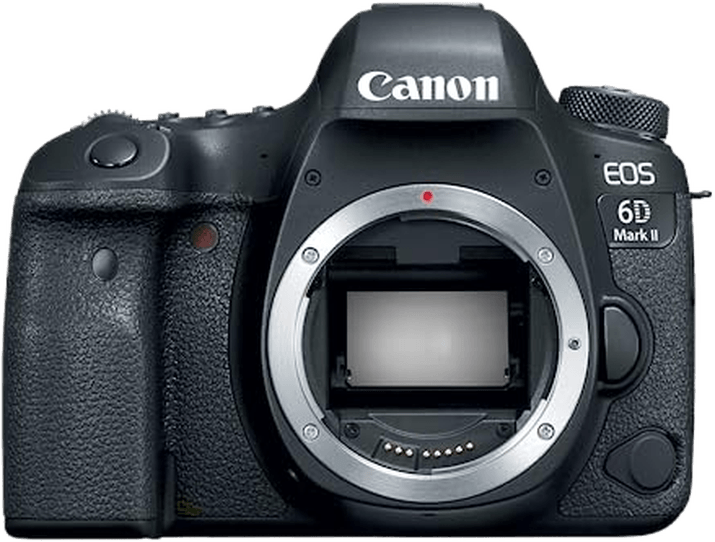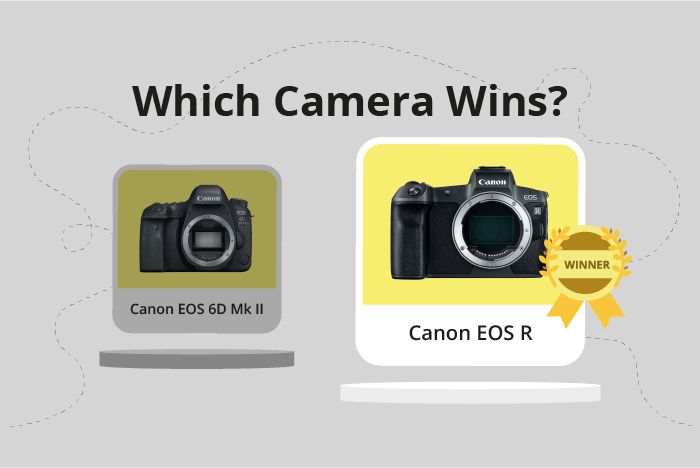Canon EOS 6D Mark II vs EOS R Comparison
Canon EOS 6D Mark II

Canon EOS R

The Canon EOS R outperforms the Canon EOS 6D Mark II with a score of 74/100 compared to 71/100. Both cameras share similarities, such as being produced by Canon and having a similar price range ($2,000 for 6D Mark II and $2,300 for the EOS R). The 6D Mark II, a DSLR camera, was released in 2017, while the EOS R, a mirrorless camera, was launched in 2018.
The EOS R has a higher score and is more compact, measuring 136 x 98 x 84mm and weighing 1.07lbs. This makes it more portable than the 6D Mark II, which measures 144 x 111 x 75mm and weighs 1.00lbs. Despite being heavier, the 6D Mark II still has its advantages, such as being more affordable.
Taking these factors into account, the Canon EOS R stands out as the better option due to its higher score, compact size, and mirrorless technology. However, the Canon EOS 6D Mark II remains a solid choice for those on a tighter budget.
Canon EOS 6D Mark II vs EOS R Overview and Optics
The Canon EOS R outperforms the Canon EOS 6D Mark II in optics, scoring 73/100 compared to the 6D Mark II’s 69/100. Both cameras share common specifications, including a CMOS sensor, full-frame sensor size, and a lack of image stabilization. However, the EOS R has a higher megapixel count (30.3), faster shooting speed (8), a more advanced processor (Digic 8), and a higher DXOMARK sensor score (89). These factors contribute to the EOS R’s superior optical performance.
The winning EOS R benefits from its increased megapixel count, providing more detail and resolution in images. Its faster shooting speed allows for capturing quick action and fleeting moments with ease. The Digic 8 processor enhances image processing, resulting in better colors, noise reduction, and overall image quality. The higher DXOMARK score for the sensor means improved low-light performance and dynamic range.
On the other hand, the EOS 6D Mark II has a lower megapixel count (26.2) and slower shooting speed (6.5), which may limit its performance in certain situations. However, it features a Canon EF lens mount, which is compatible with a wide range of Canon lenses. This could be a significant advantage for photographers who already own EF lenses or prefer the EF lens lineup.
To conclude, the Canon EOS R offers better optics due to its higher megapixel count, faster shooting speed, advanced processor, and superior sensor performance. The EOS 6D Mark II, while not as strong in these areas, has the advantage of compatibility with the EF lens system. Ultimately, the choice between these two cameras will depend on individual needs and preferences.
Canon EOS 6D Mark II vs EOS R Video Performance
The Canon EOS R outperforms the Canon EOS 6D Mark II in video capabilities, with a video score of 70 compared to the 6D Mark II’s 57. Both cameras share some common specs, such as a maximum video frame rate of 30fps and built-in time-lapse functionality. However, the EOS R has a clear advantage in certain aspects, while the 6D Mark II offers some unique benefits as well.
The Canon EOS R’s better video score is primarily due to its higher maximum video resolution of 4K and video dimensions of 3840 x 2160. This enables the EOS R to capture more detail and produce sharper, more vibrant footage than the 6D Mark II, which is limited to Full HD resolution and video dimensions of 1920 x 1080. The increased resolution gives the EOS R an edge when it comes to producing high-quality videos for professional or personal use.
Although the Canon EOS 6D Mark II has a lower video score, it still provides some advantages. For instance, the 6D Mark II’s Full HD resolution may be sufficient for many users who do not require 4K video capabilities. Additionally, the lower resolution can result in smaller file sizes, making it easier to store and transfer video files. This may be beneficial for users with limited storage space or those who prioritize ease of file management over video quality.
In comparison, the Canon EOS R is the better choice for users who prioritize video quality and require the higher resolution offered by 4K. Meanwhile, the Canon EOS 6D Mark II may be suitable for those who are content with Full HD resolution and prefer smaller file sizes for easier storage and transfer. Ultimately, both cameras have their strengths in the video department, and the choice depends on the user’s specific needs and preferences.
Canon EOS 6D Mark II vs EOS R Features and Benefits
The Canon EOS R outperforms the Canon EOS 6D Mark II with a feature score of 87/100, compared to the 6D Mark II’s score of 83/100. Both cameras share several features, including touchscreen capability, flip screens, WIFI, and Bluetooth connectivity. However, the EOS R surpasses the 6D Mark II in certain aspects, while the 6D Mark II has its own advantages.
The EOS R boasts a larger screen size of 3.2 inches and a higher screen resolution of 2,100,000 dots, compared to the 6D Mark II’s 3-inch screen and 1,040,000-dot resolution. This difference results in a clearer and more detailed display on the EOS R, making it easier to review images and navigate menus.
On the other hand, the 6D Mark II features GPS functionality, which the EOS R lacks. This allows photographers to geotag their images, making it simpler to organize and locate photos based on their shooting location. This advantage is particularly useful for travel and landscape photographers who wish to document the geographical information of their images.
Despite the 6D Mark II’s GPS advantage, the EOS R’s superior screen size and resolution make it the better choice in terms of features. The EOS R provides users with a more enjoyable and efficient experience when reviewing images and navigating menus. However, for those who prioritize geotagging capabilities, the 6D Mark II remains a viable option. In the end, the choice between these two cameras depends on the individual photographer’s preferences and priorities.
Canon EOS 6D Mark II vs EOS R Storage and Battery
The Canon EOS 6D Mark II triumphs over the Canon EOS R in storage and battery, scoring 45/100 as opposed to the EOS R’s 35/100. Both cameras possess a single memory card slot and accept SD, SDHC, and SDXC cards. The EOS 6D Mark II is compatible with UHS-I cards, while the EOS R supports the faster UHS-II cards.
The EOS 6D Mark II outperforms the EOS R in battery life, offering 1200 shots compared to the EOS R’s 370 shots. Both cameras utilize the LP-E6N battery type. However, the EOS R compensates for its shorter battery life with USB charging capability, which the EOS 6D Mark II lacks.
Despite the EOS R’s advantage in USB charging and faster memory card compatibility, the EOS 6D Mark II’s significantly longer battery life makes it the superior choice for storage and battery performance.
Canon EOS 6D Mark II vs EOS R – Our Verdict
Are you still undecided about which camera is right for you? Have a look at these popular comparisons that feature the Canon EOS 6D Mark II or the Canon EOS R:

